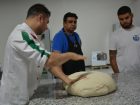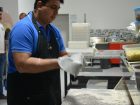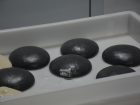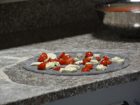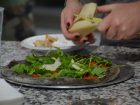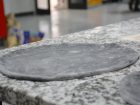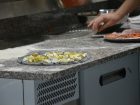
Editor’s blog: Back to pizza school
Colleen Cross
Features In the Kitchen Techniques blog charcoal editor editor's blog ingredients school of italian pizza techniquesToronto – I hadn’t been in a classroom in years when Alice Rovere invited me to check out a traditional pizza workshop at the School of Italian Pizza in Toronto. With still so much to learn about the craft and business of pizza, I was more than happy to hit the books.
Of course, there were no books at this school – only a few notes, a lot of questions and even more hands-on doing.
After a warm reception from Alice and Francesco Zulian, who run the school, I entered a decidedly chilly workshop – kept that way for obvious reasons of food safety. I encountered a cheerful group of pizzaiolos gathered around a cool marble table. I came nearer. They were opening up dough balls with more concentration and enthusiasm than anyone could be expected to muster on a Monday morning.
Instructor Danilo Lupo of Pizzeria Defina, a former International Pizza Expo champ, led the session, which consisted of six guys who clearly knew their way around a prep table and one magazine editor who obviously didn’t.
I learned that these keen students already operated restaurants – two of these fellows had had success in Dubai and were looking to open a concept in Canada. What impressed me was the fact that these successful businessmen were completely absorbed in the pizza-making process and keen to pick up a skill or three to improve their pizza and their operation.
For part of the session, we sat attentively in a classroom while Chef Danilo delivered dough basics and invaluable tips (see below). We proceeded to roll, stretch, top, and of course, sample our way through the four-hour workshop – everything from a zingy margherita to a lovely light tuna pizza with white sauce.
This was a traditional pizza-making course, but with a dark twist.
And by dark I mean black. Laid out before us were rows of shiny, black pizza dough made from food-grade charcoal-based flour. The flour is said to have several health benefits such as improving digestion and eliminating bloating by absorbing intestinal gas.
What began as a black dough ball quickly opened out into a soft, grey circle. I cannot lie: it was something to behold when opened up and stretched and looked for all the world like soft, grey fur or velvet.
It baked up into a medium grey coloured crust. My fellow students pronounced it every bit as delicious as white. “If you close your eyes while eating it, you’d never know it was a different colour,” one said with an impressed grin.
It was nice to see these seasoned pizzaiolos surprised and delighted.
I was left with the strong sense that those of you who work in pizza take a lot of pleasure – joy – in the process that keeps you going and makes you want to understand the whys and the hows of your craft and business.
I am grateful to the S.O.I.P. for giving me a bit of insight into the mind of an operator. For my 2016 New Year’s resolution, I promise to try to bring as much of that joy as possible to the pages of Canadian Pizza, by encouraging learning and sharing as many stories as possible about the craft and the business we love.
Tips from Chef Danilo Lupo
Chef Danilo delivered dough basics and invaluable tips.
- He taught us there are five different types of 00 flour, Manitoba flour being a popular one. Different flours absorb different amounts of water, he said, and he suggested buying soft wheat from wherever there is a good crop. Lucky for us, Italy and Canada currently are the biggest producers of wheat.
- Using a range of yeast is a good idea, he said, because you sometimes want to slow down the process of fermentation. “Dry active” yeast is activated once wet, and “dry” yeast must be fed water at 28 C. “Fresh yeast” can be tricky to handle and is probably best left to experienced pizza makers, he said.
- A spiral mixer is better because it pushes and breaks the dough, Danilo said, and the shape of the bowl also slows and confines the dough. “You want to let in as much air as possible,” he added.
- Salt makes the dough strong, which is important for stretching, tossing and other pizza acrobactics, he added, but be sure to keep salt and yeast as far apart as possible for as long as possible to slow the reaction.
Print this page
